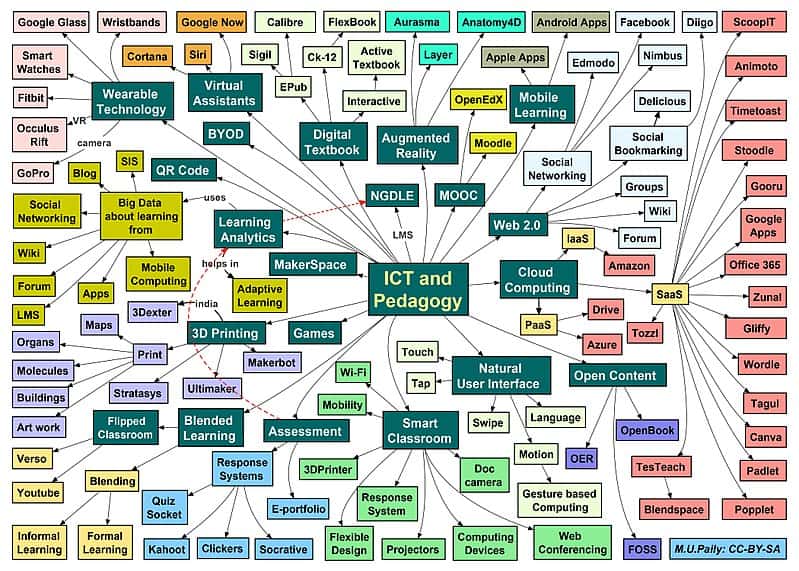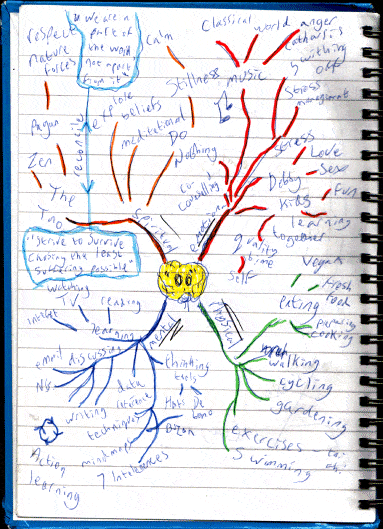
Sometimes a process doesn’t happen one step at a time. Sometimes, a problem we’re trying to solve has many moving and interacting elements.
Mind Mapping is a technique to capture those scattered thoughts, those non-linear processes, those myriads of interactions and dependencies. It’s a tool that is useful for brainstorming, organizing, and problem-solving.
What is a Mind Map?
Since a mind map is a visual representation of information, it may be best to show a couple of examples.

Image by M.U. Paily CC-BY-SA This mind map explores various innovative pedagogical approaches and the corresponding technology tools and techniques. Created 25 January 2017.
And another example of a hand-drawn mind map.

Image by Graham Burnett, GNU Free Documentation License. This mindmap (Mind map) consists of rough notes taken by the author during a course session covering aspects of wellbeing, ie, paying attention to the dimensions represented in the 4 branches radiating from the central image of physical, emotional, mental and spiritual health.
There isn’t one way to create a mind map and every map that I’ve ever seen or created have been different. They can be colorful, or not. Then can contain many branches and many interconnecting lines.
They can be simple or complex.
What they do is represent spatially a set of ideas, concepts, steps, or factors (pretty much anything) along with some indication of how those items are related. They are not a list or outline as they are non-linear by nature.
The Basic Mind Mapping Steps
The best advice when creating a mind map is to make it your own. When working with a group, be flexible and make the map as the group finds useful.
The basic steps are pretty simple.
- Start in the center with an image or topic under consideration.
- Add keywords or short phrases or images to capture key concepts, ideas, threads, ideas, tasks, etc.
- Adde brancsh to separate concept categories, differences, etc.
- Draw a connecting line between branch nodes (keywords, images, etc.) to represent some relationship, connection, or dependency.
- Add notes or definitions as necessary.
- Add more paper or screen space as necessary.
The best way to learn this technique is to do it by hand. Grab a set of colored pencils or pens, start in the center, and think and write down the first set of elements that come to mind. Add lines to represent branches, and keep going till you have completely captured your thinking, or your groups thinking about the topic.
There are computer programs and mobile apps for doing mind mapping. They differ in cost, ease of use, and feature sets. Most any tool from pen and paper, to a full-featured software application, is fine, the idea is to find one that works for you.
Uses for Mind Mapping
When I first learned about mind mapping it was in school as an alternative to note taking using an outline. When listening to a lecture or reading book my thinking would often leap back or ahead or generate ideas and connections. An outline format was too limiting for how I absorbed information. A mind map allowed me to capture the essential outline along with the bevy of connections and relationships that were apparent.
You can use mind mapping t
- take notes
- summarize an essay or book chapter
- plan a process
- plan a project
- brainstorm solutions
- organize an approach
- capture meeting minutes
- And more.
Best Practices When Mind Mapping
Colors and imagery help spark creative solutions and connection, plus help to organize and group concepts.
Keep in mind, this is a technique where the process is as or more valuable than the result. It doesn’t have to be pretty. It should allow you to fully explore an idea or problem.
Use what works for you and adjust and alter as needed to help you and your team create a visual representation of the thinking.
Have fun.
Summary
An online search for mind mapping will find many references, resources, and guidelines for those that would like to explore this technique in detail.
Maybe you could create a mind map of the ways to use or learn mind mapping and share here.
 Ask a question or send along a comment.
Please login to view and use the contact form.
Ask a question or send along a comment.
Please login to view and use the contact form.
Leave a Reply